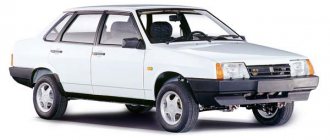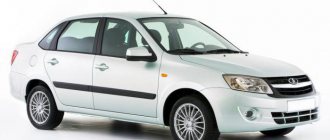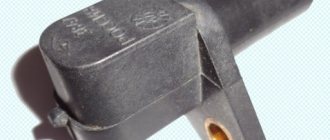All the disadvantages of the Lada Granta liftback
➖ Quality of finishing materials ➖ Extraneous noise in the gearbox ➖ Suspension
pros
➕ Spacious trunk ➕ Warm interior ➕ Economical
The advantages and disadvantages of the 2018-2019 Lada Granta hatchback in a new body were identified based on reviews from real owners. More detailed pros and cons of the Lada Granta liftback with manual, automatic and robot can be found in the stories below:
Owner reviews
About comfort. There is, one might say, no noise at all. After the Hyundai ix35 crossover, I, of course, had a culture shock for some time. Now I’m used to it and I can even say that this is the ideal car for work. First of all, thanks to the incredibly low fuel consumption.
Returning to comfort. Two conflicting opinions: for the first year and a half, my back began to ache when traveling further than 50 km (in the driver’s seat). And my wife in the back seat says that it’s much more comfortable than on the back seat of the ix35!
The robot they put on Grant is wonderful. I mean that it is practically devoid of those shortcomings that the first Opel and Toyota robots had.
The dynamics are just fire! The car is light and playful. Of course, not everyone can be left at traffic lights, but... True, after 60 km/h the dynamics begin to fall.
Alexander, review of Lada Granta Liftback 1.6 (106 hp) with AMT robot 2015
Video review
Liftback, robotic gearbox, 106 horsepower engine, electric power steering, front electric windows, 60/40 rear seat, air conditioning, etc. In general, the package is “Normal”.
The first sensations from the robot are dull (I need to get used to it, this is my first such experience), but there are no vibrations! There is no noise by definition, the wheels can be heard frankly well. The visibility in the mirrors is similar to that of televisions. It feels a little wobbly when cornering, but tolerable.
Salon? Provides enormous tuning opportunities, the main thing is not to overdo it! I'll install music, floor mats, armrest, Shumka... All this is ahead. I would like to put a spoiler, maybe the thresholds.
The owner drives a Lada Granta liftback 1.6 (106 hp) with a robot, produced in 2015.
Impression? I bought it in April, to date the mileage is 21,220 km, so far I have only changed the clearance light bulb (I don’t count the maintenance). There are advantages compared to the Priora (I don’t take into account the earlier cars I owned), but there are also disadvantages. Advantages:
— The gearbox clearly switches gears, but howls (infection).
— Running lights (on Priora low beam lamps, consumables).
— The air conditioner works better (personal opinion).
— The suspension is softer (passes speed bumps without braking).
— Fuel consumption is less.
Among the shortcomings, so far I can only note the howl of the gearbox.
Alexey, review of Lada Granta liftback 1.6 (106 hp) manual 2017
So, I’ll walk through the car, at the same time comparing Grant with Kalina.
Engine. The 16-valve engine installed here is noticeably quieter than the old eight-valve engine that was on my Kalina. It doesn't rattle like a tractor, it runs smoothly. Because of the run-in, I don’t press on the gas, I accelerate smoothly, but the potential is felt. If you have the money, I think you should buy a car with just such an engine. I didn’t regret it, although I initially wanted an eight-valve one.
Fuel consumption was scary at the beginning; the car consumed 12-14 liters in mixed mode. After about 500 kilometers, consumption dropped, and now it is 7.5 liters per hundred in the combined cycle, outside the city 5-5.5 liters. All this takes into account the fact that I don’t put pressure on the gas, I calmly accelerate and brake. My consumption on Kalina was higher - 9-9.5 liters per hundred in mixed mode.
Lada Granta increased fuel consumption reason
Granta was originally conceived as a car for the people. The next “people's car” was supposed to be distinguished by good indicators of comfort, safety, handling, and all this at an attractive price for the Russian middle peasant. Even the first working title of the project sounded like “Low cost,” which translated means “low cost.” Much attention during the development was paid to the issue of the vehicle’s efficiency during operation. It seemed that such an indicator as fuel consumption of the Lada Granta was practically no different from the indicators of its predecessor, the Lada Kalina, although in terms of size the car was classified as class “C”. But, as evidenced by reviews from the owners of this car, many experience a significant deviation from the figures stated by the manufacturer. What are the reasons for excessive fuel consumption? Let's try to figure it out together.
Lada Granta is a car for those who need an inexpensive car with low fuel consumption. Let's look at the Lada Granta's fuel consumption per 100 km.
According to the manufacturer, the average fuel consumption of the Lada Granta per 100 km is about 7 liters for the Granta Sedan and Granta Liftback models, as well as 6.8 liters for the Granta Sport models.
The engines of the Lada Granta car are small-displacement units that, in principle, cannot consume large amounts of fuel, although there are a number of factors that affect the fuel consumption of the Lada Granta:
History of creation
In 2008, AVTOVAZ came up with the idea of building a new budget car with a sedan body on the Lada Kalina platform. And already in March 2009, the first sketch of the car appeared, and in May it was decided to open a project with the in-plant index VAZ-2190.
The name for the car was chosen, as they say by the whole world, especially for this OJSC AvtoVAZ organized an all-Russian competition among car enthusiasts “A people's car - a people's name.” The winner of the competition was Krasnoyarsk resident Pavel Zakharov, it was he who suggested calling the car “Granta”; in total, several tens of thousands of names were submitted to the competition. As a reward, Zakharov was solemnly presented with a Lada Kalina car at the 2010 Moscow Motor Show.
The development of the Lada Granta car was carried out with the participation of partner OJSC AvtoVAZ in the person of. The Lada “Kalina” car platform was taken as a basis, since at that time it was the latest and most modern and most suitable for a budget car, since the “Kalina” itself was one. It took the designers two and a half years to create the Granta, followed by road tests, the results of which made it clear that the car was reliable, safe and suitable for Russian roads.
After the creation work in 2011, a roomy car with a long wheelbase and decent ground clearance appeared, which in the same year completely replaced the Lada Kalina sedan. Initially, the sedan with the factory index VAZ-2190 was the only representative of the Lada “Granta” family, and only in March 2013 a new car with a 5-door liftback body, which was assigned the index VAZ-2191, was officially presented. The liftback entered serial production in May 2014, and its production was established at the IzhAvto enterprise controlled by AVTOVAZ.
At the beginning of 2015, as a result of modernization, cars of the Lada Granta family received a standard GLONASS-GPS navigation system with the City Guide program installed.
What factors influence the fuel consumption of the Lada Granta - Factory parameters
| Fuel consumption of Lada Granta per 100 km. mechanics and automatic That is, in fact, such a route is nothing more than a theoretical construction that takes into account the manner of movement in populated areas, on rough terrain, and so on. This method cannot be called accurate, especially considering that the warning lamp on the Lada Granta lights up whenever it wants, from any hill, it can light up even from a sharp press on the brake pedal (emergency braking). |
- in urban conditions, the standard 100 km takes from 7.1 to 19.7 liters (the average value, respectively, is 11.8);
- on the highway - 6-10.2 (7.6);
- combined cycle consumption – 7.2-14.8 (10.4).
The new procedure for calculating the basic rate of fuel consumption recommended by the Ministry of Transport for 2022 • 2022 IA-159-r provides for the possibility of choosing the procedure for calculating the base rate of fuel consumption per mileage of a passenger car.
Discounts from the help desk
When you mention ACC you can get discounts on parts and services
Automotive Help Desk: auto news, spare parts in Krasnoyarsk for foreign and domestic cars, disassembled cars, car repairs, addresses and phone numbers of companies, bulletin boards, spare parts catalogues, service and repair manuals.
All information presented on the site is for informational purposes only and under no circumstances constitutes a public offer.
download photo to mobile phone
Test lamp method
Especially sharply increased fuel consumption per 100 km can be observed in the cold season. Along with gasoline, the consumption of other fluids of systems and components (oil, etc.) also increases. For LADA Granta, gasoline consumption in a given time period can increase to 2 liters. The main reason (provided the power system is working properly) is the need to warm up the engine in frosty temperatures. Indirect factors include driving on ice and the type of tires used (studs, Velcro, etc.).
Comfort and speed
Compared to previous models, the Lada Granta turned out to be quite a playful and fast car. This is confirmed not only by successes in sports competitions. In addition to the powerful power plant, the manufacturer took care of the interior design. Now this is a truly European and Western car, which has everything you need for comfortable and cozy travel. We must not forget that comfort is one of the aspects of safety.
Despite the budget class, the interior of the car is presented presentably.
- In the classic version of the Grant, it comes with door upholstery in decorative materials, separate rear seat backs, and additional sill seals. At the same time, the security system has been thought out.
- As standard, the car has inertial seat belts, airbags for passengers and drivers, and comfortable headrests.
The Grant has a steering wheel height adjustment function and an electric power steering. The car windows are made as athermal modifications. The cabin air filter and multifunctional climate control system ensure the absence of unnecessary odors and cold. It is convenient to drive Granta at any time of the year: both in the summer heat and in the winter cold.
Fuel consumption VAZ (Lada) Granta Sedan 1.6 MT (87 hp)
Official data reflects the fuel consumption provided by the manufacturer of the VAZ (Lada) Granta Sedan 1.6 MT (87 hp) , it is indicated in the car’s service book, and can also be found on the manufacturer’s official website. Real fuel consumption data is based on the testimony of owners of a VAZ (Lada) Granta Sedan 1.6 MT (87 hp) , who left information about fuel consumption on our website.
If you are the owner of a VAZ (Lada) Granta Sedan 1.6 MT (87 hp) , and you know at least some data about the fuel consumption of your car, then you can influence the statistics below. It is possible that your data will differ from the given vehicle fuel consumption figures, in which case we ask you to immediately enter this information on the website to correct and update it. The more owners add their data on the real fuel consumption of their car, the more accurate the information obtained about the true fuel consumption of a particular car will be.
The table below shows the average fuel consumption values for the VAZ (Lada) Granta Sedan 1.6 MT (87 hp) . Next to each value, the amount of data on which the average fuel consumption is calculated is indicated (i.e., this is the number of people who filled out the information on the site). The higher this number, the more reliable the data obtained.
× Did you know? The fuel consumption of the VAZ (Lada) Granta Sedan 1.6 MT (87 hp) in the urban cycle is also affected by the place of movement, since traffic congestion in populated areas varies, the condition of the roads, the number of traffic lights, the ambient temperature and many others also differ factors.
| # | Locality | Region | Consumption | Qty |
| Nizhny Novgorod | Nizhny Novgorod Region | 8.00 | 1 | |
| Ulyanovsk | Ulyanovsk region | 8.03 | 3 | |
| Ekaterinburg | Sverdlovsk region | 8.20 | 1 | |
| Cheboksary | Chuvash Republic | 8.40 | 1 | |
| Kemerovo | Kemerovo region | 8.50 | 1 | |
| Dace | Lipetsk region | 8.60 | 1 | |
| Ryazan | Ryazan Oblast | 8.70 | 1 | |
| Voronezh | Voronezh region | 9.00 | 1 | |
| Magnitogorsk | Chelyabinsk region | 9.00 | 1 | |
| Moscow | Moscow | 9.00 | 1 | |
| Omsk | Omsk region | 9.80 | 1 | |
| Novosibirsk | Novosibirsk region | 10.00 | 1 | |
| Volgograd | Volgograd region | 11.00 | 1 | |
| Mikhailovka | Volgograd region | 11.50 | 1 | |
| Nalchik | Republic of Kabardino-Balkaria | 11.50 | 1 |
× Did you know? The fuel consumption of the VAZ (Lada) Granta Sedan 1.6 MT (87 hp) in the extra-urban cycle is also affected by the speed of the car, since it is necessary to overcome the force of air resistance and wind direction. The higher the speed, the more effort the engine of the VAZ (Lada) Granta Sedan 1.6 MT (87 hp) .
Main engines
As the main engines, AvtoVAZ offers customers a choice of the power units already mentioned just above. Let's talk about each of them separately.
VAZ-11183-50
The eight-valve VAZ-11183-50 engine is an improved VAZ-2111 with a power of 82 hp, which is installed on Grant sedans and hatchbacks. The work carried out to improve the unit has increased its environmental friendliness and reliability, the level of engine torque and its elasticity have significantly increased.
The disadvantages of the VAZ-11183-50 include increased noise and the need to adjust the valves from time to time. In addition, this motor may not warm up to the required temperature due to a malfunction of the thermostat (the thermostat in such a situation must be replaced).
In addition, instability in the operation of the motor is often observed, for which there may be several reasons. For example, such instability is often associated with the burnout of one of the valves, with a violation of the integrity of the gasket, or with a malfunction of the ignition module. However, bending of the valves due to a broken timing belt will not occur.
VAZ-11186 (VAZ 21116)
VAZ 21116 is another representative of eight-valve engines with 87 hp. under the hood. It is a modified and improved VAZ-21114 engine, which is distinguished by a lower noise level and noticeable fuel economy. They are equipped with Grant's Norma vehicles.
If we compare the VAZ 21116 with the VAZ-21114, we should note a noticeably increased level of environmental friendliness, and the power has also increased significantly. The disadvantages of the engine include a more modest resource than, for example, that of the VAZ-11183. Its pistons are much lighter than those of its predecessor, but this circumstance led to the appearance of two more disadvantages.
So, in lighter pistons there is simply no room left for the recesses, therefore, if the belt breaks, the valves will definitely bend. Another disadvantage of such pistons is related to their fragility. For this reason, pistons can break when colliding with valves, and in four cases out of five such contact will require replacement.
Naturally, potential buyers will also be interested in the dynamic data of this engine. The presence of lighter pistons, which were already mentioned earlier, allowed the engine to increase not only in terms of power, but also in additional efficiency. Cars with such an engine reach speeds of up to 167 km/h, and acceleration from 0 to 100 meters will take them 12.4 seconds.
VAZ-21126
Luxury Grants are equipped with VAZ-21126 engines. These engines are direct descendants of the VAZ-21124, representing a rather serious sixteen-valve power unit with a power of 98 hp.
Cars with this power plant are distinguished by very impressive dynamic characteristics: acceleration to one hundred meters in 11.4 seconds, maximum speed of 172 km/h. Bench tests showed not only the full consistency of the declared indicators, but also the presence of reserves for exceeding them. The VAZ-2126 inherited an obvious drawback from its predecessor - a collision of valves with pistons due to a broken belt will lead to one hundred percent bending of the former.
VAZ-21127
VAZ-21127 is an improved engine of the VAZ-21126. It also has 16 valves with a power rating of 106 hp. Grant luxury vehicles are equipped with these power units.
The VAZ-21127 is distinguished by enviable torque, especially at low speed; the changes that occurred during the improvement process are not too significant, but are felt almost immediately. Another significant difference was the absence of a mass air flow sensor, instead of which the designers proposed installing absolute pressure sensors. Owners of cars equipped with the described engine note increased power compared to its predecessor. But the VAZ-21127 cannot boast of an increase in elasticity, and therefore it is not able to quickly gain momentum in higher gears.
Its disadvantages include the usual bending of the valves due to a broken belt, noise during operation, most often caused by disturbances in the functioning of the gas distribution system, and the possible loss of the engine’s power characteristics when the piston rings wear out, due to deformation of the pistons or due to wear of the cylinders.
VAZ-21126-77
It is worth mentioning one more engine that is directly related to the Grant - VAZ-21126-77. This engine is installed on Lada Granta Sport cars; this unit was the result of modernizing the VAZ-21126 engine.
One of its most important features was the increase in power when passing through the 3000 rpm mark; in terms of its other characteristics, it is practically indistinguishable from the power units described above. The engine is four-cylinder, with a volume of 1.6 liters, its power is 120 hp.
According to many sources, it is completely similar to the VAZ-21126 engine. Its disadvantage is the usual bending of the valves, which is caused by a broken timing belt.
The world's main methods for measuring the consumption of new cars External factors
With this method of determining the average fuel consumption, the result is less accurate than in the previous one, but it will qualitatively show the excess or value of the specified fuel consumption. To summarize, let's say that if you need a relatively cheap, reliable car with low Lada Granta fuel consumption per 100 km, then you should take a closer look at one of the Lada Granta cars.
| # | Locality | Region | Consumption | Qty |
| Nizhny Novgorod | Nizhny Novgorod Region | 8.00 | 1 | |
| Ulyanovsk | Ulyanovsk region | 8.03 | 3 | |
| Ekaterinburg | Sverdlovsk region | 8.20 | 1 | |
| Cheboksary | Chuvash Republic | 8.40 | 1 | |
| Kemerovo | Kemerovo region | 8.50 | 1 | |
| Dace | Lipetsk region | 8.60 | 1 | |
| Ryazan | Ryazan Oblast | 8.70 | 1 | |
| Voronezh | Voronezh region | 9.00 | 1 | |
| Magnitogorsk | Chelyabinsk region | 9.00 | 1 | |
| Moscow | Moscow | 9.00 | 1 | |
| Omsk | Omsk region | 9.80 | 1 | |
| Novosibirsk | Novosibirsk region | 10.00 | 1 | |
| Volgograd | Volgograd region | 11.00 | 1 | |
| Mikhailovka | Volgograd region | 11.50 | 1 | |
| Nalchik | Republic of Kabardino-Balkaria | 11.50 | 1 |
Features of external and internal design
VAZ 2191 is the first car with a liftback body from AvtoVAZ, and one cannot help but note a very successful debut. The appearance is much more attractive than the sedan; the more rapid lines do not deprive the car of its elegance. New front and rear bumpers, painted in body color, have a stylish design and give the car a modern look. The liftback body has less hydrodynamic resistance than its counterparts. The clever shape of the sloping roof prevents splashing on the rear window, cleaning it with air flow. New limiters on the front doors with a fine-tuning effect, which allows you to close the doors securely and easily without effort or slamming. One of the significant advantages of this car, rightfully called a family car, is the presence of a large trunk, the volume of which is 440 liters.
The interior of the VAZ 2191 is not much different from the Lada Granta sedan, but there are a number of improvements. The seats have high-quality upholstery with decorative inserts; thanks to the elastic pile of the fabric, it better supports the driver’s back when cornering. The seats, as well as the steering wheel, can be adjusted to suit your anatomical features.
The most expensive equipment - luxury prestige - is equipped with:
- rear seat head restraints,
- heated mirrors and a joystick for adjusting them,
- two airbags,
- climate control,
- large 7-inch on-board computer display with touch control,
- electric steering and other pleasant little things.
The interior height and legroom in Lada Granta liftback cars of all trim levels is quite sufficient, even tall drivers and passengers will not feel discomfort.
LadaGranta 1.6 (82 hp) – External factors
| Fuel consumption on the Lada Granta We were pleasantly surprised by the owners of cars of this model, who tell on the forums that the real fuel consumption on an 8-valve Lada Granta with an engine power of 82 hp. Such Lada Granta models have the same 1.6 liter engine with a power of 98, 106 and 120 model sport versions of horsepower and are equipped with an automatic and manual transmission. |
Cars with a 16-valve engine • The simplest of them, and as it seems to me the most biased, is carried out using a fuel warning lamp.
Lada Granta liftback 2019-2020 owner reviews
- Review
- Prices
- Characteristics
- Photo
- Video
- Reviews
All the disadvantages of the Lada Granta liftback
➖ Quality of finishing materials ➖ Extraneous noise in the gearbox ➖ Suspension
pros
➕ Spacious trunk ➕ Warm interior ➕ Economical
The advantages and disadvantages of the 2019-2020 Lada Granta hatchback in the new body were identified based on reviews from real owners. More detailed pros and cons of the Lada Granta liftback with manual, automatic and robot can be found in the stories below.
Owner reviews
About comfort. There is, one might say, no noise at all. After the Hyundai ix35 crossover, I, of course, had a culture shock for some time. Now I’m used to it and I can even say that this is the ideal car for work. First of all, thanks to the incredibly low fuel consumption.
Returning to comfort. Two conflicting opinions: for the first year and a half, my back began to ache when traveling further than 50 km (in the driver’s seat). And my wife in the back seat says that it’s much more comfortable than on the back seat of the ix35!
The robot they put on Grant is wonderful. I mean that it is practically devoid of those shortcomings that the first Opel and Toyota robots had.
The dynamics are just fire! The car is light and playful. Of course, not everyone can be left at traffic lights, but... True, after 60 km/h the dynamics begin to fall.
Alexander, review of Lada Granta Liftback 1.6 (106 hp) with AMT robot 2022
Video review
Liftback, robotic gearbox, 106 horsepower engine, electric power steering, front electric windows, 60/40 rear seat, air conditioning, etc. In general, the package is “Normal”.
The first sensations from the robot are dull (I need to get used to it, this is my first such experience), but there are no vibrations! There is no noise by definition, the wheels can be heard frankly well. The visibility in the mirrors is similar to that of televisions. It feels a little wobbly when cornering, but tolerable.
Salon? Provides enormous tuning opportunities, the main thing is not to overdo it! I'll install music, floor mats, armrest, Shumka... All this is ahead. I would like to put a spoiler, maybe the thresholds.
The owner drives a Lada Granta liftback 1.6 (106 hp) with a robot, produced in 2018.
Impression? I bought it in April, to date the mileage is 21,220 km, so far I have only changed the clearance light bulb (I don’t count the maintenance). There are advantages compared to the Priora (I don’t take into account the earlier cars I owned), but there are also disadvantages. Advantages:
— The gearbox clearly switches gears, but howls (infection).
— Running lights (on Priora low beam lamps, consumables).
— The air conditioner works better (personal opinion).
— The suspension is softer (passes speed bumps without braking).
— Fuel consumption is less.
Among the shortcomings, so far I can only note the howl of the gearbox.
Alexey, review of Lada Granta liftback 1.6 (106 hp) manual 2019
So, I’ll walk through the car, at the same time comparing Grant with Kalina.
Engine. The 16-valve engine installed here is noticeably quieter than the old eight-valve engine that was on my Kalina. It doesn't rattle like a tractor, it runs smoothly. Because of the run-in, I don’t press on the gas, I accelerate smoothly, but the potential is felt. If you have the money, I think you should buy a car with just such an engine. I didn’t regret it, although I initially wanted an eight-valve one.
Fuel consumption was scary at the beginning; the car consumed 12-14 liters in mixed mode. After about 500 kilometers, consumption dropped, and now it is 7.5 liters per hundred in the combined cycle, outside the city 5-5.5 liters. All this takes into account the fact that I don’t put pressure on the gas, I calmly accelerate and brake. My consumption on Kalina was higher - 9-9.5 liters per hundred in mixed mode.
Transmission. Gears shift easier and more clearly than on Kalina. On Kalina it was impossible to stick the first one at low speed, on Grant it was easy. The box howls, but it was the same on Kalina.
Suspension. Honestly, I thought it would be softer. As I understand it, this is exactly the case on sedans, but on liftbacks, in my opinion, the suspension handles bumps more harshly. But still better than on my old Kalina. Significantly better.
Interior and quality of materials. Just as spacious as in Kalina, but due to the change in the front panel and the shape of the glove compartment there is less legroom for the front passenger. The plastic and its scratch resistance will be slightly worse than that of the first generation Kalin plastic. The hardness of the plastic in both cars is approximately the same.
The seats are firmer than on Kalina and hold their shape better. The material of the seat upholstery and floor did not cause any complaints, but because of the black color, every speck is visible.
Body iron. One hundred percent thinner than the first generation Kalinas. You can often read or hear that the metal is the same. Now, that's not true. Just for fun, click in different places. The bumpers are made of very thin plastic; on Kalina everything was much more solid.
Fuel consumption of 8-valve engines
The first copies of the Lada Granta, which appeared in 2011, were equipped with gasoline injection engines models 11183 and 11186 with a volume of 1.6 liters and a power of 82 and 87 hp. respectively. The use of a power supply system with distributed injection and a lightweight connecting rod and piston group made it possible to achieve a reduction in consumption in all driving modes. With a combined cycle, the 82-horsepower Lada Granta has a gasoline consumption of 7.4 liters, and with the 11186 engine - 7.0 liters per 100 km. When driving in the city it will be 9.7 and 9.0 l/100 km, and on the highway - 6.1 and 5.8 l/100 km, respectively.
In fact, the fuel consumption of the sedan differs significantly from the official data: outside the city it is about 6.6 liters, and in the combined cycle - 8.5 l/100 km. Differences in fuel consumption largely depend on the operation of the vehicle under conditions that differ significantly from laboratory conditions (ground tests). The use of low quality fuel and lubricants makes a significant contribution.
Disadvantages of the model
There are no perfect cars. You need to understand the purpose for which you are buying a car. When operating a premium car in off-road conditions, it will have no fewer disadvantages than a crossover when driving on the autobahn. The second important indicator is the price-quality ratio. You have to pay for comfort. The complexity of manufacturing, materials for interior decoration, sound insulation and other options for a luxury car will cost much more than for a budget car.
However, all versions of the Grant liftback have common disadvantages. First of all, this is very poor sound insulation of the wheel arches and especially the roof. When driving on gravel or a wet road, you get the feeling that your feet will be drenched in water, and when it rains, you get the feeling that there is a metal basin above you instead of a roof. The design of the window lifts is not well thought out, the windows do not open all the way, which is especially inconvenient when paying for parking or opening the barrier when entering a parking lot.
The noise level of the gearbox is quite high, however, this is typical for all VAZ models. The size of the digital information displayed on the on-board computer display is insufficient, you have to strain to read the values, this distracts attention from the road. Other minor shortcomings can be easily tolerated.
The Lada Granta liftback, conceived by AvtoVAZ designers as a budget family car, almost meets the ideal combination of price-quality criteria. This is certainly a step forward for the Russian automobile industry. The car has fairly good technical characteristics, high passive safety, is economical, has a stylish modern design and a very comfortable interior.
Release date: April 16, 2013
Factors leading to excessive fuel consumption
According to the manufacturer, the average fuel consumption of the Lada Granta per 100 km is about 7 liters for the Granta Sedan and Granta Liftback and 6 models. The main thing is not to exceed the parameters recommended by the manufacturer, because very high pressure will increase the rigidity of movement, in addition, the danger will increase tire rupture on difficult sections of the road.
Technical characteristics of the car
The five-door Granta model with a liftback body absorbed the best qualities of its classmates, retaining the strong body of a sedan and the large trunk volume of a hatchback. At the same time, she has a swift, dynamic appearance. To enhance the strength of the body, additional stiffening ribs were used, located between the trunk floor and the wheel arches, and the thickness of the floor and side members was also increased. The raised window line, sloping roof and new body kit, front and rear bumpers added originality to the design. Improved aerodynamics of the car made it possible to reduce hydrodynamic resistance, reduce fuel consumption and eliminate contamination of the rear window.
The Granta liftback is available in standard, classic, comfort and luxury trim levels. To designate a particular configuration, indices are added to the main model number. For example, VAZ 219110 is standard, VAZ 219170 is classic start, and so on.
The geometric dimensions of the Lada Granta liftback are shown in the figure.
The main technical and dynamic characteristics of the Grants in the liftback body are given in tables 1 and 2.
Table 1. Car parameters depending on the type of engine and gearbox
Units and parameters
Indicators
Table 2. Characteristics of the Lada Granta liftback depending on the configuration
Equipment
Number of valves
Since the release of the first batch of Lada Granta liftback, several crash tests have been carried out. The first one was made in the Czech Republic with one airbag, the result was 8.4 points out of 16. Not bad for a car in this class, considering the performance of such cars as Hyundai Solaris (8.5 points), Hyundai Accent (8.9 points), Chevrolet Lanos (8.1 points) and Fiat Albea (7.5 points). The geometric dimensions of the passenger compartment remained almost unchanged upon impact, and the driver, if this had happened, would not have received any damage other than fright.
Assessing the handling of the liftback, we can state: thanks to the improved aerodynamic shape, roll in corners has decreased, although only slightly, the car has better road holding.
Reviews about fuel consumption of Lada Granta 1.6 (87 hp). External factors
This technique is criticized for the reason that many models with an additional electric motor can travel most of this short distance without using the internal combustion engine. Official data states that the fuel consumption rate of the Lada Granta on the highway is 5.6 liters, in the combined cycle no more than 6.8 liters, and in the city only 8.6 liters per 100 kilometers.
| Engine (model) | Engine power (hp) | Engine capacity (cc) | Fuel consumption in the urban cycle (l/100 km) | Fuel consumption outside the city (l/100 km) | Combined fuel consumption (l/100 km) |
| 11183 | 82 | 1596 | 9.7 | 6.1 | 7,4 |
| 11186 | 87 | 1596 | 9 | 5.8 | 7,0 |
| 21116 | 87 | 1596 | 9 | 5.8 | 7,0 |
New Lada Granta liftback 2022: photo and price, specifications
The Moscow Motor Show was the place where the long-awaited restyling of one of AvtoVAZ’s popular cars, the Lada Granta (liftback) 2022, was shown. The previous version of the car was a huge success among young people, as it looked decent and cost a little.
The new model will be better in many respects. Here the exterior will become more stylish, the interior will change quite a lot, but the characteristics, unfortunately, will remain at the same low level.
Pros and cons of the Lada Granta liftback
- Patency
- Economical
- Design
- Liquidity
- Trunk
- Visibility
- Reliability
- Microclimate
- Economical
- Music
- Build quality
- Paint quality
- Transmission
- Salon
Reviews from Lada Granta liftback owners
Somehow it turned out that I bought this!))) In general, I have complaints about the steering wheel, brakes and the howling gearbox... But in general it’s good for getting your butt to work and back. In short, we are getting used to the behavior of the car... The plans are to throw out the jeep-like struts and add controllability with the help of spacers, etc., and then we’ll see.
I’ve been driving a Granta liftback for more than a year and a half, I always try to use good spare parts in case of repairs, but consider breakdowns a rarity for us, considering that I drive it shamelessly both on business and at work. I think I'm constantly driving, but the Lada holds up well! In general, I consider my grant to be the best option for the Russian automobile industry and the indicators are obvious. So much on the road and still be the same peppy car!
As for noise insulation: you can communicate with a person on the street directly from your car, and it doesn’t matter whether your doors are open or not. The ground clearance is good, but the threshold on the driver’s side will not agree with me (jammed). In general, the car is ok, I have never owned foreign cars, I have nothing more to say.
A beautiful and practical spacious liftback body. A robot is just a fairy tale, tearing the jaws of those who scold it is better than mechanics and more practical than an automatic machine. And in traffic jams, and in slush, and through mud - the car simply becomes universal. The engine is a separate issue, the 27 engine with 106 horses confidently accelerates the car to maximum speed, which is very helpful on the highway, and you can also very confidently use it for aggressive driving around the city!
The high ground clearance of the car allows you to ignore a large number of Pripyat on the road. The machine is very maintainable, spare parts cost pennies, it can be repaired with a dozen tools, almost on the knee. Assembly on the body without any complaints, while disassembling the interior - I was amazed at how all the wires were secured, everything was in harnesses, and in other fastening materials, in general the car is above all praise.
Reviews of Lada Granta car owners with photos on drom.ru, drive2.ru, auto.ru and auto.mail.ru
Lada Granta liftback 2022 prices and specifications
The price of the Lada Granta liftback 2022 in Russia ranges from 478,900 to 666,800 rubles, the car is offered in Standart, Classic, Comfort, #CLUB and Luxe trim levels.
| Equipment | price, rub. |
| 1.6 (87 hp) Standard MT5 | 478 900 |
| 1.6 (87 hp) Classic MT5 | 512 500 |
| 1.6 (87 hp) Classic Optima MT5 | 538 500 |
| 1.6 (87 hp) Comfort MT5 | 558 500 |
| 1.6 (106 hp) Comfort MT5 | 573 500 |
| 1.6 (87 hp) #CLUB MT5 | 575 900 |
| 1.6 (106 hp) Classic Optima AMT5 | 578 500 |
| 1.6 (106 hp) #CLUB MT5 | 590 900 |
| 1.6 (87 hp) Luxe MT5 | 596 800 |
| 1.6 (106 hp) Comfort AMT5 | 598 500 |
| 1.6 (106 hp) Luxe MT5 | 611 800 |
| 1.6 (98 hp) Comfort AT4 | 628 500 |
| 1.6 (106 hp) Luxe Prestige MT5 | 630 800 |
| 1.6 (106 hp) Luxe AMT5 | 636 800 |
| 1.6 (98 hp) #CLUB AT4 | 645 800 |
| 1.6 (106 hp) Luxe Prestige AMT5 | 655 800 |
| 1.6 (98 hp) Luxe AT4 | 666 800 |
* MT5 - five-speed manual transmission, AT4 - four-speed automatic transmission, AMT5 - five-speed robot
Technical characteristics of Lada Granta Liftback
Body
| Body type | hatchback |
| Car class | class B |
| Length / width / height, mm | 4250 / 1700 / 1500 |
| Wheelbase, mm | 2476 |
| Ground clearance (ground clearance), mm | 160 |
| Trunk volume, l | 520 |
| Curb weight, kg | 1058 — 1100 |
| Fuel tank volume, l | 50 |
Engine and transmission
| engine's type | petrol | petrol |
| Volume, l | 1,6 | 1,6 |
| Power, hp | 87 | 106 |
| Torque, Nm | 140 | 148 |
| Gearbox type | Mechanics | Mechanics |
| Number of gears | 5 | 5 |
| Drive unit | front | front |
| Acceleration 0-100 km/h, s | 11,8 | 10,6 |
| Max speed, km/h | 171 | 183 |
| Fuel consumption, l | ||
| - city | 9,1 | 8,7 |
| - track | 5,3 | 5,2 |
| - mixed | 6,8 | 6,5 |
| Fuel type | AI-95 | AI-95 |
Engine and transmission
The world's main methods for measuring the consumption of new cars • Driving style
| What is the gasoline consumption of the Lada Granta per 100 km, 8 and 16 valves? Due to the high cost and high fuel costs, cars with a robotic gearbox are in less demand among potential owners of the Lada Granta. The indicator can be influenced by the following factors: time of year in winter, consumption is higher, the quality of gasoline, the manufacturer recommends refueling 95AI, traffic jams in the city, consumption is higher, driving style, experts advise smooth acceleration and smooth braking, air conditioning, when using it, consumption increases by about 1 liter. |
- city roads - 8.6 l;
- highway - 5.6 l;
- mixed cycle - 6.7 l.
Alternative engines
VAZ-21904
VAZ-21904 is a gasoline-powered sixteen-valve turbo engine with a displacement of 1.4 and a power of 163 hp. In addition, it is equipped with a lithium-ion battery and an electric motor. The basis for it was the VAZ-11194 engine; it was installed on Lada Kalina cars in the first generation. As for the VAZ-21904 itself, it is installed on Grant hybrids - VAZ-21904 sedans. The Volzhsky Automobile Plant tested four such vehicles equipped with three different hybrid engine options.
Fifth gear was replaced by the shaft of a robotic gearbox; it rotates thanks to a small electric motor with a power of 11 kW. This option turned out to be simpler and cheaper than using the standard scheme with the electric motor located between the gearbox and the internal combustion engine. Thus, there are four gears left, but this aspect will not create any problems for the car owner - the maximum speed (160 km/h) is achieved by the car in fourth gear.
Also, the terms of reference required the developers to fulfill two mandatory conditions - charging a hybrid car from electrical networks used in everyday life and the ability to move it in two modes at once - combined and electric. AvtoVAZ’s partners in the development of electronics were the Russian research institute NAMI and the Ricardo company from the UK. It was NAMI that developed the battery and electric motor for a hybrid car.
The car is capable of starting to move purely on electric power, with the internal combustion engine switched off. During the process of gaining speed, the gear shift will be carried out by a “robot”, and the precise output of the electric motor is responsible for synchronizing the rotation of the gears at this moment. When you start the gasoline engine, the car will begin to work in hybrid mode - with the same gear shifting, in which the electric motor will either help rotate the input shaft of the box, or will switch to generator mode, charging the battery.
According to tests, a hybrid car will consume 21% less fuel than a Granta with a conventional 1.6 engine. (measurements, of course, were carried out in a gentle mode, but the result obtained is very good).
Of course, only a few hope that the hybrid Lada Granta will be in great demand and will be able to generate any significant interest in the car market in the near future. At the moment, such vehicles are nothing more than a kind of aggregate carriers intended for testing various components separately. If we talk specifically about the hybrid type transmission, its serial production will begin in at least two to three years, and it will be installed on quite expensive Lada cars, most likely C-class. Thus, it is quite possible over time and we should expect an increase in demand for hybrid cars, but the main condition for this is a fundamental change in the attitude towards “ecological” transport not only of motorists, but also of the state, as well as the vehicle manufacturers themselves.











